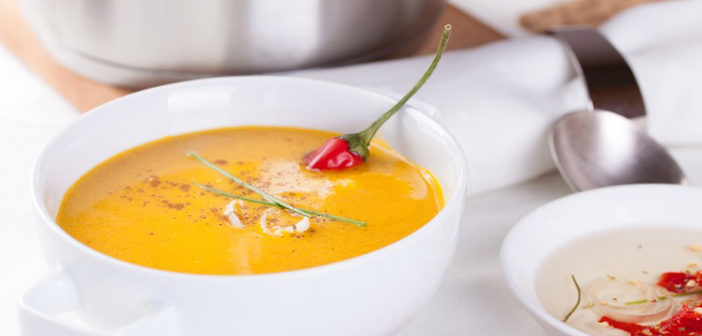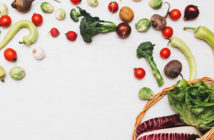When it comes to our health, we’ll try anything once and do whatever it takes to enhance and improve it. We’ll swap our coffee for energy-boosting minerals, add chlorella to our smoothies, and rearrange our homes like an energy healer all in the name of healthy living. To find out what lies ahead in the wellness world in 2017, we searched the Google trends to share the entire scoop with you.
The latest trends you can look forward to in 2017 include soups instead of juices, meditation apps, stress reduction, natural dentistry, adaptogens and reducitarianism. I am happy to say that the Sevalife is ahead of the 2017 curve. Our patients have already been incorporating some of the trends for 2017 into their everyday lives and have been reaping the benefits.
Here is what we found:
1. Soup
“While it’s similar to juicing (in that it promises to give your digestive system a break), so using soups is less likely to induce headaches, energy crashes, and that weight-gain rebound juice cleanses are known for,” said Livestrong writer and chef Ariane Resnick. “Where juicing removes your food supply completely—leaving you with only the nutrient-laden water pressed out of whole-produce items—”souping” allows you to consume food, and plenty of it. This means you can spend a few days or a week consuming healthy, whole-food soup meals without feeling deprived.”
If you use bone broth as the soup base, Resnick says you’ll receive even more benefits, such as reduced inflammation, improved digestion, joint repair, and more.
2. Ashwagandha
Half Baked Harvest
“Ashwagandha is an adaptogen, which means it helps you adapt to stressors. Although there is limited research on this claim, it is also thought to help improve sleep quality. The only time you should avoid ashwagandha is if you’re pregnant or are taking immunosuppressants, sedatives, or thyroid hormone medication.
Many Sevalife clients have experienced tremendous benefits from adding Ashwaganda to their daily regimens myself included.
3. Natural Dentistry
Finally, the smile is hitting the big stage. Cosmetic dentistry has been the rage for a while but it’s all about the foundation of your smile now. If your bone, gums, tissues are not healthy then it doesn’t matter how much you invest in cosmetics. So supporting a healthy balance of good and bacteria in the mouth is the key.
Biological dentistry, holistic dentistry are terms you may be familiar with, but it goes deeper than that. Natural dentistry or what I like to call whole health dentistry is making the connection between your mind body and your smile. Probiotics and foods that support all of you also support your healthy smile.
And there are a host of things one can do from home to get the healthiest smile. PH strips to check your acid/alkaline balance, coconut oil, natural toothpaste mixtures that contain calcium power not fluoride. Dr Stukes suggest working on the building blocks of your smile every day. Find an oral health specialist that will take the time to educate you on true self care of your smile.
4. Watermelon Water
Watermelon water is being touted as the new coconut water. You can even find it in the grocery store now thanks to brands like WTRMLN WTR. So what is it exactly? Watermelon water is really just cold-pressed watermelon.
So what are the benefits to juicing and drinking watermelon? Watermelon is a powerful source of vitamin C plus flavonoids such as lutein, lycopene, and beta-carotene. These antioxidants protect the body against free radicals, which can cause inflammation, osteoarthritis, rheumatoid arthritis, asthma, strokes, and heart attacks. Watermelon can also lessen skin damage caused by the sun.
According to Google trends, watermelon water will steadily rise in popularity with a spike around June next year.
5. Mushroom Elixir
According to Organic Authority, mushrooms possess anti-cancer and anti-inflammatory properties, boost the immune system, provide protein, and contain beneficial antioxidants. They are also considered to be adaptogens, or substances that help the body adapt to stress and hormone fluctuation.
Medicinal mushrooms? Many cultures have called mushrooms medicinal and have for centuries, especially in folk medicine, yet their compounds have just recently been studied. The active constituents that make these mushrooms “medicinal” are primarily polysaccharides including beta-glucans and triterpenes.
Reishi (Ganoderma lucidum) used for: enhancing the immune system, hypertension, hyperlipidemia, viral infections such as the flu (influenza), swine flu, avian flu, cancer, inflammatory disease, cardiovascular disease, and asthma and bronchial diseases, reducing stress, kidney disease, hepatitis and liver disease, HIV/AIDS, altitude sickness, supporting chemotherapy, preventing fatigue, chronic fatigue syndrome (CFS), insomnia, and gastric ulcers.
Shiitake used for: enhancing immune system, cardiovascular health, anticancer, antimicrobial, antibacterial, inhibiting cell growth seen in prostate cancer, hepatotoxicity and more.
Chaga used for: anticancer, antioxidant, in immunotherapy, an anti-inflammatory, diabetes, etc.
Maitake used for: cancer prevention, chronic fatigue syndrome (CFS), hepatitis, hay fever, diabetes, high blood pressure, hyperlipidemia, weight loss or control, polycystic ovary syndrome (PCOS), cancer including breast cancer, and chemotherapy support.
King oyster used for: preventing and treating the common cold, influenza, allergies, atherosclerosis, snake and insect bites, bronchitis, cachexia, prevention of cardiovascular disease, cholera, colic, diabetes, diarrhea, flatulence, gastritis, gonorrhea, hemorrhoids, hepatomegaly, jaundice, leprosy, leptospirosis, malaria, skin wounds, skin diseases, ulcers, used as an astringent, antiseptic, anti-inflammatory, antithrombotic, expectorant, anthelmintic, laxative, and tonic.
Cordyceps used for: strengthening the immune system, improving athletic performance, reducing the effects of aging, promoting longevity, treating lethargy, and improving liver function in people with hepatitis B. It is also used to treat coughs, chronic bronchitis, respiratory disorders, kidney disorders, frequent nocturia, male sexual dysfunction, anemia, heart arrhythmias, high cholesterol, liver disorders, dizziness, weakness, tinnitus, wasting, and opium addiction. Also used as a stimulant, a tonic, and an adaptogen which is used to increase energy, enhance stamina, and reduce fatigue.
Many if not all of these “medicinal” mushrooms also are loaded with nutrients: B vitamins, zinc, manganese, choline, dietary fiber, vitamin D, copper, antioxidants, anti-inflammatory compounds, and more.
Note some of these mushrooms when taken orally in higher concentrations than if you were to just eat may interact with other herbal supplements, herbs or medication- just throwing that out there; always be careful if you’re new to a food. Also, some mushrooms may cause allergic reactions in some individuals, start slow and gradual.
Nutritionist Mckel Hill has created a tonic with the benefits of mushrooms and turmeric.
Ultimate Mushroom Tonic | Nutrition Stripped
Prep time: 5 mins Cook time: 5 mins Total time: 10 mins
Serves: 1
An antioxidant and anti-inflammatory packed tonic containing mushrooms, turmeric, cinnamon, and sweet dates with cashew milk. VGN GF Paleo
INGREDIENTS
1½ cups homemade cashew milk
1 tablespoon chia seed
1 tablespoon ground flax seed
1 tablespoon melted coconut oil
1 tablespoon local honey
1-2 medjool dates, pitted
2 tablespoons raw cacao powder
½ teaspoon turmeric
½ teaspoon of each organic powdered cordyceps, reishi, shiitake, chaga, maitake, and king oyster OR use 1 tablespoon of a mushroom mix
Pinch of sea salt
Using dried mushrooms: take 1-2 dried mushroom of each shiitake, chaga, king oyster, cordyceps, maitake, and reishi and soak at room temperature in about 2-3 cups of water until mushrooms are soft, about 1 hour. Strain and use this liquid for the recipe- note, the taste will be very earthy in comparison of using a freeze dried mushroom mixed powder (as suggested).
INSTRUCTIONS
Simply combine all ingredients into a high speed blender and blend until smooth. Adjust sweetness by adding additional dates
Serve chilled over ice or serve warm by pouring into a small saucepan and gently heating until warm to touch.
6. Kava
From an unknown Chinese tradition to the supermarket aisle, kombucha officially became mainstream in 2016. But according to wellness experts, the next little-known ancient remedy that’s about to sit alongside it in your fridge is kava.
This buzzy drink is a super-chill alternative to alcohol, and interest in the beverage is on the rise worldwide. “Made from grinding the roots of the kava plant, kava has been a staple of South Pacific cultures for thousands of years. But thanks to a marketing makeover, kava is now being served as a healthier alternative to alcohol with kava bars opening throughout the U.S.”
“Enthusiasts claim it produces a more euphoric and relaxing effect than alcohol,” said chef Ariane Resnick.
7. Sage Smudging
The use of dried white sage is a 2,000 year old Indigenous American practice. The shamans used dried sage plants on their fires as a ritual of calling upon ancestral spirits. Any conflict, anger, illness or evil was absorbed by the sage smoke to be released or cleansed from the energy field of a person. You can never really smudge too much! It is a great way to reinvigorate and bring energy to your home and life.
Some ideal (or necessary) times to sage smudge your aura and/or space would be:
When you move into a new living space
When you begin a new job or start your own business
Before and after a guest enters your home
Before and after a yoga or healing session
Before meditation
After an argument or any illness
Upon returning home from crowded situations
Before or after a negative person has entered your home (this is an important one)
And here is a simple 3-step sage smudging ritual to try:
1. Use loose dried white sage or a white ceremonial sage bundle (aka wand), which is usually bound together by a thin string. You can find sage bundles at your local herb shop or health store, Wiccan/pagan bookstore, metaphysical store, and even some yoga and healing arts centers. Or, if you have a sage plant, you can make your own — just bundle and tie it, and then hang upside down in cool dark space until it is completely dried out.
2. Next, place it on any heat-proof burning surface like an Abolone Shell — a traditional vessel used by Indigenous American people that represents the element of water. Light the bundle by holding a flame to it until it begins to smoke. If a true flame appears, shake the bundle gently or blow until it is just embers and smoke. I often find that I have to re-light my sage bundle a few times during the ritual process. If you are burning loose leaf sage, the best method is to use a charcoal burning disk inside of a censor or small cauldron.
3. Once you have a nice smoke going, use you hand or a feather to direct the smoke over your body from your feet up to your head, and then back down again. As you do this, visualize the smoke taking away with it any negative energy from your life, any darkness or malady.
If you feel comfortable with this incantation, repeat the following:
“Air, fire, water, earth. Cleanse, dismiss, dispel.”
The sage ceremony lifts the veil between the everyday and the sacred. As you say your incantation, you are shifting energy at will.
Once you have smudged your body, begin to move through your space. Wave the smoke into all corners, across doorways and into shadow spaces. To maintain the atmosphere of ritual, keep repeating the incantation in your mind as you diffuse the smoke.
Once the space is cleared, allow the sage bundle to either burn out or gently press it out in your heat-proof shell or container. You can even bury the remaining smudge in your garden to really feel the completeness of the cleansing ritual. Once buried, the sage has done its work in completing the elemental cycle. Ideally, you should try to use a new smudge for each cleansing.
8. Reducetarianism
Move over veganism and vegetarianism, reducetarianism is here. At Sevalife, we encourage our patients to make this healthy transition. So no worries about living a strict and restrictive diet but just adding more green and pushing away a bit more of the animal products. The phrase was first coined by co-founder and president of the Reducetarian Foundation Brian Kateman after he introduced it on the TEDx Talk stage in 2014.
The term (which continues to spike in popularity on Google Trends) empowers individuals to cut back on meat (meatless Monday’s anyone?) and welcome more plants into their diet, which Kateman feels will be “at least, in part, a key to solving complex problems like global warming and the loss of biodiversity.”
“Interest in reducetarian and vegan diets, as well as other plant-based eating and flexitarianism, continue to grow in popularity as concern grows over meat production’s environmental impact and the inhumane factory farming process, “The USDA expects a continued decline in meat consumption, with the average American eating 12.2% less meat today than in 2007,” she continued. “In May, the Guardian reported veganism has increased 350% in the past 10 years in the U.K., largely among millennial who are becoming exposed to vegan eating options and recipes via Instagram. Many celebrities such as Beyoncé and Jay-Z have tried part-time vegan diets, and others such as Ellen Page, Alicia Silverstone, Woody Harrelson, Liam Hemsworth, Miley Cyrus, Russell Simmons, and Ellen DeGeneres are full-time vegans.” Why not give reducetarianism a try? You can start with a 7,14 or 21 day whole food cleanse.
9. Meditation Apps
We’ve all heard again and again that meditation will help them relax and ‘be present,’ but for busy people with busy brains, meditating can feel like such a challenge. The new apps and gadgets offer free, short guided meditations to help users set daily and weekly meditation goals and stick to them. We also offer short guided meditations that you can access at any time to get your Om on.




